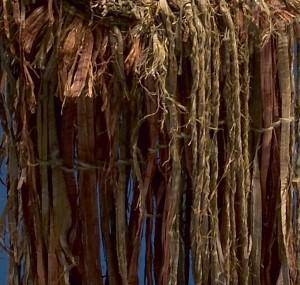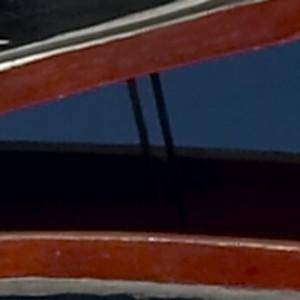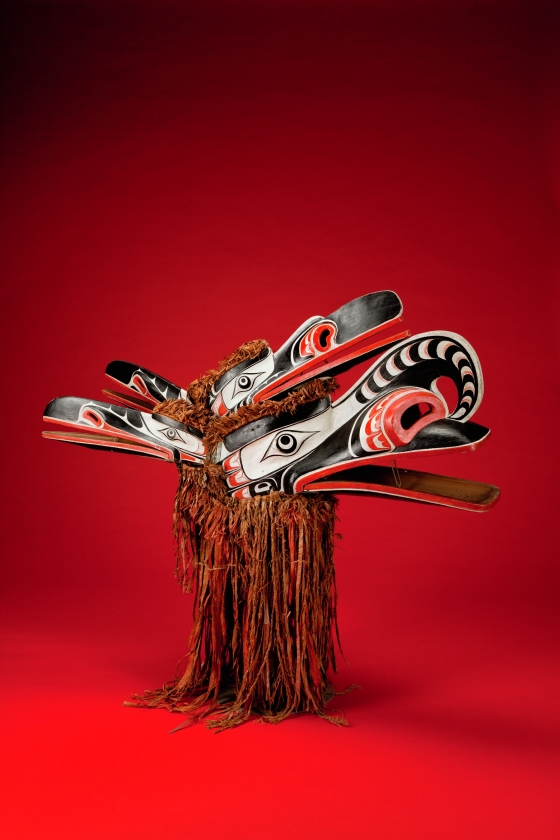Students will describe the artistic characteristics of the Four-faced Hamat’sa Mask, explain the meaning of initiation ceremonies and coming-of-age celebrations, and work in small groups to create a poster that describes and explains the significance of particular coming-of-age celebrations.
Students will be able to:
- describe the artistic characteristics of the Four-faced Hamat’sa Mask;
- explain the meaning of initiation ceremonies and coming-of-age celebrations; and
- work in small groups to create a poster that describes and explains the significance of particular coming-of-age celebrations.
Lesson
- Warm-up: Display or pass out copies of the Four-faced Hamat’sa Mask and invite students to look carefully and share what they observe. What do they notice? What colors appear on the mask? What materials were used to make the mask? Which parts of the mask seem to be movable? If the birds on the mask were alive, what kinds of sounds do you think they might make? What might be the purpose of the mask? What adjectives would they use to describe the mask?
- Share with students that the mask was created by George Walkus in 1938. Walkus was a member of the Kwakwaka’wakw [KWALK-WALK-ya-WALK-wuh] Indian tribe from Northern Vancouver Island and British Columbia. Have the students locate Northern Vancouver Island and British Columbia on a large map.
- Explain to students that masks are an important part of ritual dances and aid in telling the stories of the tribe. Masks like this one are worn during the dances of the Hamat’sa society, the highest ranking Kwakwaka’wakw dancing society. This mask represents the Crooked Beak of Heaven, who is an integral character in the Hamat’sa winter dances. The mask is worn by members who appear during the society’s initiation ceremony.
- Inform students that an initiation ceremony is a ceremony in which a person becomes a member of a club, society, or other organization. Ask the students what kinds of initiation ceremonies they are familiar with. Have any of them ever participated in or seen an initiation ceremony in which people were recognized as new members of a sports team, Boy Scouts or Girl Scouts troop, or some other group? What happened during the initiation ceremony?
- Share with students that most of the initiates in the Hamat’sa ceremony are boys on the verge of manhood. Explain that some initiation ceremonies also indicate that a person is moving from childhood into adulthood. This type of ceremony is also known as a rite of passage or a coming-of-age celebration. Ask the students if they know the names of any ceremonies or rites of passage in the United States that mark the transition from childhood into adulthood (e.g. bar/bat mitzvah, “sweet sixteen” party, quinceañera).
- Have the students break into small groups and assign each group a particular coming-of-age celebration to research. Make sure the students have Internet access to conduct their research; or you may want to download information or assemble materials ahead of time. Encourage the students to discover what happens during each of these types of celebrations, who would be invited, where the celebrations would be held, how long the celebrations last, and what special significance the celebrations have for the participants.
- Once students have completed their research, have each group create a poster that summarizes the information they have learned about the coming-of-age celebration they investigated.
- Invite the students to share their findings with the rest of the class. Lead a class discussion on the similarities and differences among the different types of coming-of-age celebrations. Remind students to give themselves a round of applause for a job well done!
Materials
- One large sheet of chart paper or poster board and colored markers for each group of students
- Access to the Internet or other research materials with information about coming-of-age celebrations
- Copies of About the Art section on the Four-faced Hamat’sa Mask (included with the lesson plan) or student access to this part of Creativity Resource online
- One color copy of the mask for every four students, or the ability to project the image onto a wall or screen
Standards
- Social Studies
- History
- Geography
- Analyze historical sources using tools of a historian
- Become familiar with United States historical eras, groups, individuals and themes
- Become familiar with United States family and cultural traditions in the past and present
- Become familiar with World geography
- Recognize similarities and differences about regions and people using geographic tools
- Use geographic tools and sources to answer spatial questions
- Visual Arts
- Observe and Learn to Comprehend
- Relate and Connect to Transfer
- Envision and Critique to Reflect
- Language Arts
- Oral Expression and Listening
- Research and Reasoning
- Writing and Composition
- Reading for All Purposes
- Collaboration
- Critical Thinking & Reasoning
- Information Literacy
- Invention
- Self-Direction
Four-faced Hamat'sa Mask
- George Walkus, Kwakwaka'wakw, Canadian, about 1890 - about 1950
- Work Locations: British Columbia
- Active Dates: 1920s - 1930s
This mask was carved by George Walkus, an artist we know very little about. He was an active carver in the 1920s and 1930s. Walkus was a member of the Kwakwaka’wakw [KWALK-WALK-ya-WALK-wuh] Indian Tribe from Northern Vancouver Island and British Columbia. The Kwakwaka’wakw are known for their skillful wood carvings, particularly their masks and totem poles. Individual carvers often attempt to leave a personal mark on the objects they carve by creating slight variations to the traditional mask form. Because masks like this one were commissioned for a specific purpose and were meant to create a certain dramatic effect, the best carvers were highly sought after.
Masks are an important part of ritual dances and aid in telling the stories of the tribe. They often depict important animals and ancestral spirits. Masks like this one are worn during the dances of the Hamat’sa society, the highest ranking Kwakwaka’wakw dancing society. This mask represents the Crooked Beak of Heaven, or the Cannibal Spirit, who is an integral character in the Hamat’sa winter dances. The wide, flat mouth and curved beak distinguish this kind of mask. It is worn by members who appear during the society’s initiation ceremony. The dance revolves around a young initiate to the society who is kidnapped and taken into the woods by the Cannibal Spirit. The boy, on the verge of manhood, becomes wild and needs a series of songs and dances to tame him. The entire dance tells the story of his capture and return to the human world.
Winter dances are highly dramatic and are performed inside dimly lit structures around a central fire. George Walkus used a variety of techniques to enhance the theatrical effect of the mask. The colors, for example, had to be visible in the dim lighting. Walkus used bold blocks of red and black color and painted white around the eyes to reflect light from the ceremonial fire. Rhythmic designs draw the viewer’s eyes to certain parts of the mask—the characteristic curve of the largest bird’s beak, the prominent nostrils, and the beaks of the three smaller birds—and bring these areas to life. Walkus attached cedar-bark fringe to the bottom of the mask in order to camouflage the wearer. The fringe sways with the dancer as he crouches, jumps, and moves throughout the room. Sound is crucial to the drama of the mask’s appearance. Hidden inside is a series of strings that the dancer uses to open and close the beaks, creating a loud clapping noise. The movement and sound created by the beaks add surprise and drama to the ritual, emphasizing the voracious nature of the spirit. Walkus outlined each bird’s mouth with red, making the movement of the beak even more striking. The viewer sees only the external beauty of the mask, never realizing the complexity of its operation.
Details

Birds
The Crooked Beak is the largest bird seen here and is recognized by the large arched beak. A crane sits on top of the Crooked Beak bird and has a slight raise to its beak. Two raven heads project from the back of the mask.

Cedar Bark Fibers
Below the mask is a shield made of bark fibers that come from the yellow cedar. This serves to camouflage the wearer during the dance. In addition, dancers wear a cape of shredded cedar bark that falls to their ankles, enhancing the effect of movement. Bark is also attached to the top of each bird creating a feather-like effect.

Paint
Walkus used traditional colors to paint the mask. Black serves as the primary color, red outlines the nostrils and lips, and white can be found in and around the eyes. Paint adds to the dramatic effect of the dance as light reflects off of the shiny mask.

Strings
Concealed somewhat in the mouths of the birds are strings that were used to move the birds’ beaks. The beaks can be snapped one at a time or all together. During the dance, viewers would not be able to see the intricate network of strings that was hidden inside the mask.
Funding for object education resources provided by a grant from the Morgridge Family Foundation. Additional funding provided by the William Randolph Hearst Endowment for Education Programs, and Xcel Energy Foundation. We thank our colleagues at the University of Denver Morgridge College of Education.
The images on this page are intended for classroom use only and may not be reproduced for other reasons without the permission of the Denver Art Museum. This object may not currently be on display at the museum.






